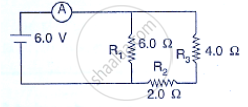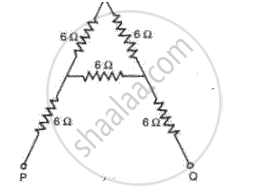Advertisements
Advertisements
Question
In 10 s, charge of 25 C leaves a battery, and 200 J of energy are delivered to an outside circuit a result.
What is the p.d. across the battery?
Solution
Given:
Time, t = 10 s
Charge, Q = 25 C
Energy delivered = Work done, W = 200 J
Using the relation, V = W/Q
V = 200/25 = 8 V
So the p.d. across the battery is 8 volts.
APPEARS IN
RELATED QUESTIONS
The work done in moving a unit charge across two points in an electric circuit is a measure of:
(a) current
(b) potential difference
(c) resistance
(d) power
What is the unit of electric current?
Which of the two is connected in series : ammeter or voltmeter?
Three resistors of 6.0 𝛀, 2.0𝛀 and 4.0𝛀 are joined to an ammeter A and a cell of e.m.f. 6.0 V as
shown in fig 8.52 Calculate:
(a) the effective resistance of the circuit and
(b) the reading of ammeter.

A bulb marked 12 V, 24 W operates on a 12 volt car battery for 20 minutes. Calculate:
(i) The current flowing through it, and
(ii) The energy liberated.
Find the effective resistance in the following circuit diagrams (Fig.):

One unit of electrical energy consumed is equal to 1000 kilowatt-hour.
A current of 1 A is drawn by a filament of an electric bulb. Number of electrons passing through a cross section of the filament in 16 seconds would be roughly
1020 electrons, each having a charge of 1.6 x 10-19 C, flows in a circuit V is 0.1s. What is the current in ampere?
